The 9th of December 1783 saw the first executions on Newgate's "New Drop" gallows, when nine men and one woman were hanged simultaneously by Edward Dennis and William Brunskill for a variety of offences. The gallows was on wheels and was brought out specially for each hanging by a team of horses. It was a large box like structure with two uprights supporting two parallel beams from which a maximum of a dozen criminals could be hanged at once. The prisoners stood on a platform, 10 feet long by 8 feet wide, released by moving a lever or "pin" acting on a drawbar under the drop. They now fell roughly to knee level. The "New Drop” had 96 customers between February and December of 1785, with 20 men being hanged on the 2nd of February of that year. By the mid 1820's, as hangings became less frequent, the double beam gallows was replaced with a single beam pattern which could still accommodate six prisoners at a time.
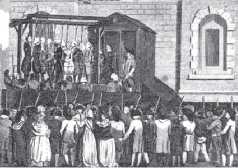
The "New Drop" pattern was copied by the county gaols and soon became universal, as executions were moved from their previous sites on the outskirts of towns to the actual prison. The gallows was normally big enough to accommodate two or three prisoners side by side and was erected for each execution. The platform was between 3 and 5 feet high and shielded by either wooden boards or black cloth drapes to conceal the legs and lower body of the prisoner in their final struggles. The trapdoors were released either from underneath by withdrawing bolts or latterly from on top of the platform by pulling a lever. In some parts of the country, the gallows had far more steps up to the platform. The “New Drop” was typically erected directly outside of, or on top of the gatehouse roof of county gaols, thus sparing the prisoner the long and uncomfortable ride to the place of execution in a cart. It was also more secure and much easier to police.
Some prisons used a balcony type gallows (as at York after 1868 and Lancaster from 1800 to 1868 where the prisoner was brought directly onto the platform through first floor French windows of the “Drop Room”.
After the passing of the Capital Punishment Amendment Act of 1868, all executions had to take place within the walls of county prisons. The existing gallows was generally used, set up in the prison yard rather than in public.
Prisons that had more frequent hangings mostly had execution sheds built in one of their exercise yards to house the gallows. The shed stood apart from the main buildings and necessitated a fairly lengthy walk from the condemned cell. In some cases the gallows were set up in the prison van’s shed. The trapdoors were typically installed over a brick lined pit. With the coming of the long drop the pit was deepened to about 12 feet deep, as drops of up to 10 feet were not unusual in William Marwood's time. Having the gallows in a separate building spared the other prisoners from the sound of the trap falling and made it easier for the staff to deal with the execution and removal of the body afterwards.
The gallows beam at Newgate was wide enough to accommodate four prisoners side by side, as was needed for the execution of the "Lennie Mutineers" on the 23rd of April 1876. In 1881, a new gallows was built for Newgate, consisting of two stout uprights with a cross beam. Normally only one iron band was fitted to the cross beam in the centre and from it 6 links of circular chain dangled, to which the rope was attached. Additional iron bands could be added for multiple hangings. On each of the uprights, was a pulley for raising the trapdoors which were operated by a lever on the platform and fell against 3 bales of cotton in an attempt to muffle the noise. All the woodwork was painted a dull buff colour.
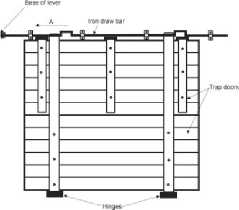
Prior to 1884, each county was responsible for providing the gallows for carrying out the death sentences passed in that county, and therefore all sorts of designs were in use. In 1885, the Home Office commissioned Lieutenant Colonel Alton Beamish to design a standard gallows for use throughout the country. This consisted of two uprights with a cross beam in 8 inch section oak. The beam was long enough to execute 3 prisoners side by side and was set over a 12 feet long by 4 feet wide two leaf trap set level with the surrounding floor. The trapdoors were made from 3 inch thick oak and were released by a metal lever set into the floor of the execution chamber. This was a great improvement over some of the designs then in use and considerably speeded up the process. The beam had one or more iron bands attached to it from which hung lengths of chain for
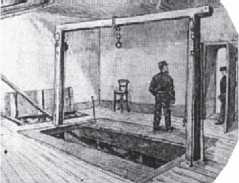
The gallows at Kirkdale
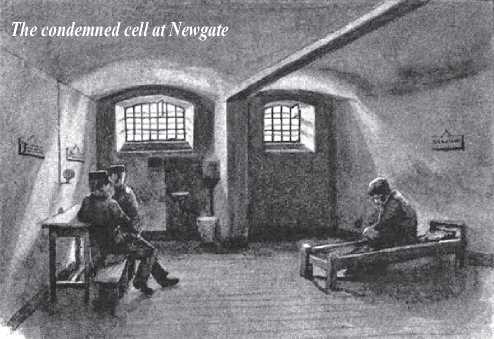
Attachment of the rope using "D" shackles. This made the setting of the drop more accurate. The first person to die on the new style "stepfree" gallows was Matthew William Chadwick in 1890, at Kirkdale Prison in Liverpool. The gallows in the execution shed at Wandsworth prison around 1900 is one of the very few to have been actually photographed - you can see the lever, open trap and one of the boards laid across the drop for the warders to stand on whilst holding the prisoner.
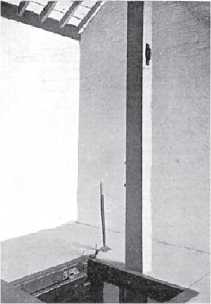
In the thoughtful way of the Home Office, at least some of these gallows had the Royal Coat of Arms displayed on the beam which must have been a great comfort to the condemned!
In the early 20th century, the Victorian pattern single beam was replaced by two beams of 8 inch x 3 inch section oak, running parallel to each other about 2 inches apart. From the centre of the beams, rose two heavy gauge metal brackets each drilled with holes offset at half inch centres through which a metal pin was inserted and to which a length of chain was attached. This allowed very much more accurate adjustment of the drop. This mechanism was further refined to allow the drop to be set to within a quarter of an inch. The beams were 8 feet above the trapdoors and were generally set into the wall at each end, there being no uprights.
The trapdoors were reduced in length as multiple hangings were no longer favoured and normally consisted of two leaves each of 4 to 8 feet in length and each 2 feet wide. The one nearest the lever being conventionally hinged whilst the other had extended hinges that ran under the first leaf and were held on top of an iron drawbar which had three slots. The trap was operated by a lever on top of the platform which moved the drawbar.
When the slots in the drawbar lined up with the ends of the extended hinges of the opposing door, the hinge ends were no longer supported and thus cause the trap to open allowing the prisoner to drop through into the cell below. The doors were caught by rubber lined catches to stop them bouncing back and hitting the criminal. It was normal for the hangman to make a chalk T on the trap so that the prisoner's feet could be correctly positioned exactly over the centre of the two leaves.
During the early 1900's, there was a move to reduce the number of "hanging prisons" and in those where executions were to continue, purpose built condemned suites were constructed within a wing of the prison on three floors. One or two condemned cells were created on the first floor within 15 -20 feet of the execution room. On the ground floor was a cell into which the trap doors opened and often an autopsy room immediately adjacent to it. The 2nd floor room contained the gallows beams, their ends set into the walls, where the drop could be set in safety, without the need for stepladders. The rope was suspended from a chain, attached to an adjustment
Wandsworth
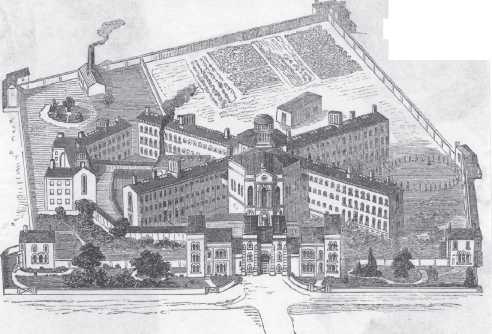
Mechanism bolted to the beams and hung down through a hatch into the execution room below. Two other ropes were also attached to the beams, one on each side of the noose, for the officers supporting the prisoner to hold onto with their free hand.
Pentonville
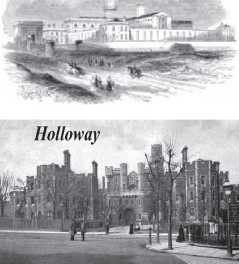
Strangeways
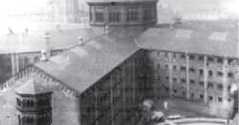
Pentonville, Wandsworth and Holloway in London all used this arrangement as did Durham, Strangeways and Walton prisons. This pattern remained standard, with minor improvements up to abolition. Typically what the prisoner saw was the trapdoors, the lever and the noose hanging down from the ceiling. Britain's last working gallows, at Wandsworth prison, was dismantled in 1994 and was sent to the Prison Service Museum in Rugby, being now stored in the Galleries of Justice in Nottingham but not on display. It was last used on the 8th of September 1961 and was kept in full working order up to 1992, being tested every six months.




 World History
World History









